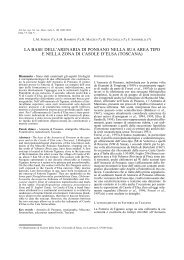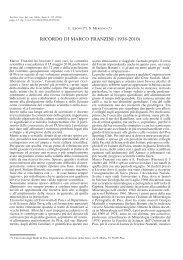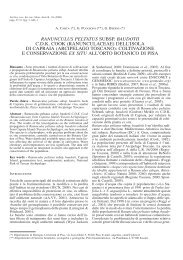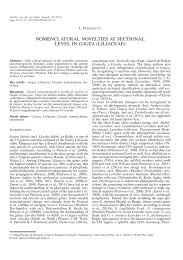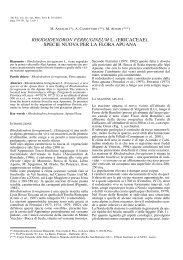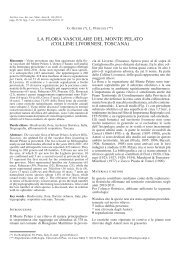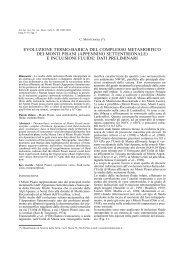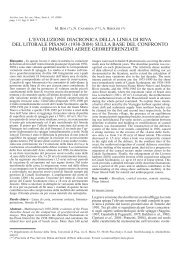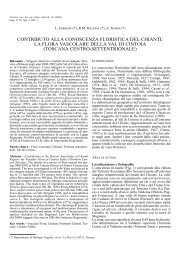Apri pdf - Società Toscana di Scienze Naturali
Apri pdf - Società Toscana di Scienze Naturali
Apri pdf - Società Toscana di Scienze Naturali
You also want an ePaper? Increase the reach of your titles
YUMPU automatically turns print PDFs into web optimized ePapers that Google loves.
Atti Soc. tosc. Sci. nat., Mem., Serie B, 118 (2011)<br />
pagg. 67-74, figg. 3, tab. 1, tav. 1; doi: 10.2424/ASTSN.M.2011.24<br />
S. Farina (*)<br />
Late Pleistocene mammals from Grotta Cucigliana<br />
(Monte Pisano, Italy)<br />
Abstract - The study of the fossil mammals from the «Grotta<br />
Cucigliana» collection is here updated. The standard taphonomic<br />
parameters NISP, MNE and MNI were established to<br />
evaluate the relative frequencies of the taxa. Hypotheses regar<strong>di</strong>ng<br />
the environmental con<strong>di</strong>tions under which the fauna lived<br />
are also proposed on the basis of the results and the ecology<br />
of the species identified. Mammals are dominated by Crocuta<br />
crocuta spelaea and Cervus elaphus but the presence of Stephanorhinus<br />
hemitoechus, Equus ferus, Bos primigenius, Rupicapra<br />
rupicapra and Dama dama is also significant. The study<br />
permits to hypothesize the occurrence of two faunal assemblages<br />
(Cucigliana A and B). The biochronological correlations<br />
herein proposed in<strong>di</strong>cates that the Cucigliana A assemblage<br />
should be referred to the end of the MIS 5a or the beginning<br />
of MIS 4, and Cucigliana B to the beginning of the MIS 3.<br />
Key words - Mammals, Monte Pisano, Late Pleistocene,<br />
biochronology.<br />
Riassunto - I mammiferi del Pleistocene Superiore della Grotta<br />
<strong>di</strong> Cucigliana (Monte Pisano, Italia). Vengono presentati<br />
i risultati dello stu<strong>di</strong>o della collezione storica della Grotta <strong>di</strong><br />
Cucigliana, conservata presso il Museo <strong>di</strong> Storia Naturale<br />
e del Territorio e il Dipartimento <strong>di</strong> <strong>Scienze</strong> Archeologiche<br />
dell’Università <strong>di</strong> Pisa. Il lavoro ha consentito il recupero e la<br />
revisione sistematica dei resti fossili. Il calcolo dei parametri<br />
tafonomici standard NISP, MNE e MNI ha permesso una valutazione<br />
delle abbondanze relative dei taxa. La fauna è dominata<br />
da Crocuta crocuta spelaea e Cervus elaphus, ma significativa<br />
è anche la presenza <strong>di</strong> Stephanorhinus hemitoechus, Equus<br />
ferus, Bos primigenius, Rupicapra rupicapra e Dama dama.<br />
Lo stu<strong>di</strong>o ha permesso <strong>di</strong> ipotizzare la presenza <strong>di</strong> 2 associazioni<br />
faunistiche (Cucigliana A e B) riferibili al Pleistocene<br />
Superiore vissute in con<strong>di</strong>zioni climatico-ambientali <strong>di</strong>verse.<br />
Inoltre, vengono tentate delle correlazioni biocronologiche tra<br />
queste associazioni e altre faune a mammiferi note rinvenute<br />
in numerosi depositi del versante tirrenico dell’Italia centrale<br />
e riferite al Pleistocene Superiore.<br />
Si ipotizza che l’associazione Cucigliana A sia riferibile alla<br />
fine dello sta<strong>di</strong>o isotopico 5a o all’inizio dello sta<strong>di</strong>o isotopico<br />
4, mentre l’associazione Cucigliana B all’inizio dello sta<strong>di</strong>o<br />
isotopico 3.<br />
Parole chiave - Mammiferi, Monte Pisano, Pleistocene Superiore,<br />
biocronologia<br />
Introduction<br />
The Monte Pisano, which is an isolated mountain located<br />
between the Arno and Serchio valleys (Fig. 1) (Rau<br />
& Tongiorgi, 1974), is paleontologically well known<br />
from the second half of 1800 because of the abundant<br />
and wealthy fossil vertebrate paleosites which were<br />
there <strong>di</strong>scovered (see Bianucci & Lan<strong>di</strong>ni, 2005 for an<br />
extensive review).<br />
The South-Western side of Monte Pisano is rich in karst<br />
caves and quarries abundant in Late Pleistocene mammal<br />
fossils (Farina, 2010), such as those <strong>di</strong>scovered at<br />
«Buca dei Ladri» (Bianucci, 1980), «Cava la Croce»<br />
(Agnano) (Tavani, 1951), «Cava le Conche» (Caprona)<br />
(Tavani, 1951) and the most important «Grotta Cucigliana»,<br />
«Grotta Parignana» (Caterini, 1921; Del Campana,<br />
1925) and «Grotta del Leone» (Car<strong>di</strong>ni, 1947;<br />
D’Eugenio, 1990).<br />
Grotta Cucigliana (Acconci, 1880; Del Campana, 1912;<br />
1914) (North Latitude 43°41’13.5» – East Longitude<br />
10°33’12») is located at 28 m a.s.l. in the small centre<br />
of Cucigliana, near Vicopisano (Fig. 1). The cave (Fig.<br />
2) was <strong>di</strong>scovered in 1878 (Acconci, 1880) and the first<br />
<strong>di</strong>gging was carried out in 1879 <strong>di</strong>rected by Meneghini<br />
and Acconci, who collected abundant mammal remains<br />
(Acconci, 1880). In later times, other specimens were<br />
recovered by Del Campana (1912; 1914). The fauna<br />
was examined by Acconci (1880), Del Campana (1912;<br />
1914) and, subsequently, by Mirri (1999). Mammals<br />
include abundant Crocuta crocuta spelea, Cervus elaphus,<br />
Bos primigenius and Equus ferus and the mammal<br />
association is a Late Pleistocene fauna (Mirri, 1999).<br />
The material is abundant, but the fossils were unfortunately<br />
collected without taking into account their exactly<br />
stratigraphical provenance albeit Acconci’s efforts<br />
(1880). This caused the loss of valuable stratigraphical<br />
information.<br />
The aim of the present work, besides the updating of<br />
the classification of the Grotta Cucigliana paleontological<br />
collection, is comparing the Cucigliana faunal<br />
assemblages with the most important Late Aurelian<br />
(Gliozzi et al., 1997) mammal associations of Tuscany<br />
and Latium. The biochronological correlations herein<br />
reported improve the framework of the Late Pleistocene<br />
faunas of central Italy.<br />
Materials and methods<br />
The paleontological collection of Grotta Cucigliana,<br />
which is now housed mainly at Museo <strong>di</strong> Storia Naturale<br />
e del Territorio dell’Università <strong>di</strong> Pisa with a small<br />
part stored at Dipartimento <strong>di</strong> <strong>Scienze</strong> Archeologiche<br />
dell’Università <strong>di</strong> Pisa, consists of 1,013 specimens<br />
(*) Museo <strong>di</strong> Storia Naturale e del Territorio dell’Università <strong>di</strong> Pisa, via Roma 79, 56011 Calci (Pisa), Italy. E-mail: simonefarina@inwind.it
68 S. FARINA<br />
Fig. 1 - Map of the Monte Pisano area. The * represents the geographic position of «Grotta Cucigliana» (Ragaini, 1992; mo<strong>di</strong>fied).<br />
inclu<strong>di</strong>ng also 18 fragments of coal and terra-cotta<br />
artefacts. A part of the paleontological collection of<br />
Cucigliana is also stored at Museo <strong>di</strong> Geologia e Paleontologia<br />
dell’Università <strong>di</strong> Firenze and is not included<br />
in this study.<br />
The present study first included the anatomically and<br />
taxonomically determination of the specimens, in order<br />
to update the previous analysis.<br />
The Number of Identified Specimens (NISP) (Grayson,<br />
1984) and the Minimum Number of Elements (Lyman,<br />
2008) were then established to evaluate the relative frequencies<br />
of the taxa.<br />
In order to assess the biomasses represented in the<br />
sample, the Minimum Number of In<strong>di</strong>viduals (MNI)<br />
(Chaplin, 1971) was also calculated.<br />
MNE and MNI have been assessed both on post-cranial<br />
and cranial specimens, taking into account age and size.<br />
The analysis of NISP, MNE, and MNI, together with<br />
the ecologic features of determined mammals, allowed<br />
to make assumptions on the environmental con<strong>di</strong>tion<br />
under which the fauna lived.<br />
Fauna<br />
The fossil material is fairly well preserved, and the<br />
determined species are reported in Tab. 1.<br />
The presence of Dama dama, Ursus arctos, Felis silvestris,<br />
and Erinaceus europaeus has also been reported<br />
by Mirri (1999), but not by Acconci (1880).<br />
Even though Acconci (1880) reported Capra? and Felis<br />
leo, the systematic review of the fossil material does<br />
not confirm the presence of such taxa in the present<br />
collection.
Late Pleistocene mammals from Grotta Cucigliana (Monte Pisano, Italy)<br />
69<br />
The specimens determined by Acconci (1880) as Felis<br />
antiqua, Mus sylvaticus and Elephas antiquus var. nana<br />
are herein reported as Panthera pardus, Apodemus<br />
ex gr. A. sylvaticus-flavicollis and Elephas antiquus,<br />
while the specimens determined as Lepus variabilis are<br />
reported as Lepus sp. because the remains of this taxon<br />
lack truly <strong>di</strong>agnostic elements.<br />
Results<br />
Of the 995 mammal specimens examined here, 14<br />
could be determined only anatomically, and 5 of them<br />
are sesamoid bones, while 61 specimens are completely<br />
undetermined. The NISP, MNE, and MNI counts are<br />
reported in Tab. 1.<br />
Macromammals are dominated by Crocuta crocuta<br />
spelaea (NISP = 299; MNI = 18) and Cervus elaphus<br />
(NISP = 191; MNI = 28); Bos primigenius (NISP = 87;<br />
MNI = 10) and Equus ferus (NISP = 84; MNI = 9) are<br />
less abundant, while the other faunal components are<br />
slightly represented. Noteworthy is also the presence<br />
of Stephanorhinus hemitoechus, Rupicapra rupicapra,<br />
Dama dama and Sus scrofa.<br />
Discussion<br />
Fig. 2 - Plan of «Grotta Cucigliana» [1].<br />
The absence of clear stratigraphic information about this<br />
fauna impacts on its paleoclimatic and paleoenvironmental<br />
significance. In spite of these limits, the paleoecologic<br />
in<strong>di</strong>cations of the determined species together with the<br />
evaluation of NISP, MNE and MNI allow assumptions on<br />
the environmental settings of the <strong>di</strong>fferent faunal associations.<br />
Moreover, the comparison of the Cucigliana mammal<br />
assemblages with the most important Late Pleistocene<br />
faunal associations from Tuscany and Latium,<br />
gives a clearer idea of Grotta Cucigliana biochronology.<br />
The faunal association of Grotta Cucigliana includes a<br />
mixture of species that lived in <strong>di</strong>fferent environmental<br />
and climatic con<strong>di</strong>tions. Therefore, two faunal assemblages<br />
(Cucigliana A and Cucigliana B) have been<br />
identified on paleoecological basis (Farina, 2010).<br />
The first assemblage (Cucigliana A) is characterized<br />
by Capreolus capreolus (MNI = 8), Cervus elaphus<br />
(MNI = 28), Dama dama (MNI = 16), Sus scrofa<br />
(MNI = 4), Ursus arctos (MNI = 1), Canis lupus<br />
(MNI = 4), Canis aureus (MNI = 1), Vulpes vulpes<br />
(MNI = 6), Stephanorhinus hemitoechus (MNI = 4)<br />
and Elephas antiquus (MNI = 1). The assemblage<br />
in<strong>di</strong>cates general temperate climatic con<strong>di</strong>tions and<br />
a forested and humid environment as suggested by<br />
the presence of Cervus elaphus, Capreolus capreolus,<br />
Sus scrofa, Dama dama, with open areas (grassland)<br />
included (Stephanorhinus hemitoechus and Elephas<br />
antiquus).<br />
In the biochronological framework of the Late Pleistocene<br />
mammal associations of Tuscany (Fig. 3), the<br />
Cucigliana A assemblage is probably younger than<br />
the Monte Tignoso mammal association (Del Campana,<br />
1910; Malatesta, 1943), which is referred to the MIS 5e<br />
or 5c (Caloi & Palombo, 1994), where abundant pachyderm<br />
remains in<strong>di</strong>cating temperate-warm con<strong>di</strong>tions<br />
were recognized (elephant, hippopotamus and steppe<br />
rhinoceros). The more recent age of Cucigliana A<br />
assemblage is suggested by the scanty remains of<br />
steppe rhinoceros (NISP = 11; MNE = 10) and elephant<br />
(NISP = 2; MNE = 2).<br />
On the other hand, the Cucigliana A assemblage, is<br />
probably older than the Grotta Gosto association (Tozzi,<br />
1974), where the climate was probably cooler, as<br />
suggested by the presence of chamois (48 specimens;<br />
Tozzi, 1974) and by the progressive <strong>di</strong>sappearance of<br />
pachyderms (only scanty remains of an indeterminate<br />
species of rhinoceros were recognized; Tozzi, 1974).<br />
The Grotta Gosto mammal assemblage is referred to the<br />
beginning of MIS 3 (Caloi & Palombo, 1994).<br />
In the Latium coast, there are mammal associations<br />
(referred to the end of the MIS 5a or to the beginning<br />
of MIS 4) similar to Cucigliana A. In fact, the mammals<br />
from «Canale Mussolini» or «Canale delle Acque<br />
Alte» (Blanc, 1935; Blanc et al., 1957; Farina, 2011)<br />
and, in particular, the faunal assemblage from layer C2<br />
(Farina, 2011), is characterized by the occurrence of<br />
roe, red, and fallow deer that in<strong>di</strong>cates temperate and<br />
forested settings. The association in the layer C2 of<br />
this deer assemblage with horse and auroch remains,<br />
together with steppe rhinoceros and elephant, in<strong>di</strong>cates<br />
the presence of open areas as well. In the layer C2, also<br />
the presence of hippopotamus is recognized (Farina,<br />
2011). Other mammal associations of Latium, which<br />
are characterized by the presence of steppe rhinoceros<br />
associated with a fauna of mixed environment, are those<br />
of «Grotta Guattari», «Grotta della Catena», and «Grotta<br />
del Fossellone» (Caloi & Palombo, 1994).<br />
In conclusion, the Cucigliana A assemblage could be<br />
tentatively correlated biochronologically with the late<br />
MIS 5a or early MIS 4 mammal associations of the<br />
Latium coast and consequently could be earlier than<br />
the MIS 4 climatic deterioration (Fig. 3).
70 S. FARINA<br />
Tab. 1 - NISP, MNE and MNI values of the «Grotta Cucigliana» fauna.<br />
Order Species NISP MNE MNI<br />
Insectivora Erinaceus europaeus 4 4 3<br />
Rodentia<br />
Arvicola amphibius 8 8 1<br />
Apodemus ex gr. A. sylvaticus-flavicollis 1 1 1<br />
Lagomorpha Lepus sp. 30 29 4<br />
Meles meles 6 6 2<br />
Mustelidae 1 1 1<br />
Canis lupus 10 10 4<br />
Canis aureus 1 1 1<br />
Vulpes vulpes 16 16 6<br />
Carnivora<br />
Ursus spelaeus 31 29 4<br />
Ursus arctos 3 3 1<br />
Felis sylvestris 3 3 1<br />
Lynx lynx 2 2 1<br />
Panthera pardus 37 35 9<br />
Crocuta crocuta spelaea 299 241 18<br />
Perissodactyla<br />
Stephanorhinus hemitoechus 11 10 4<br />
Equus ferus 84 82 9<br />
Sus scrofa 38 37 4<br />
Capreolus capreolus 16 16 8<br />
Cervus elaphus 191 188 28<br />
Artiodactyla<br />
Cervus vel Dama 3 3<br />
Dama dama 29 28 16<br />
Rupicapra rupicapra 6 6 2<br />
Bos primigenius 87 86 10<br />
Proboscidea Elephas antiquus 2 2 1<br />
Primates Homo sapiens 1 1 1<br />
Total values 920 848 140<br />
Anatomically determined specimens 14 14<br />
Total determined specimens 934 862 140<br />
The second assemblage (Cucigliana B) is characterized<br />
by Rupicapra rupicapra (MNI = 2), Bos primigenius<br />
(MNI = 10), Crocuta crocuta spelaea (MNI = 18),<br />
Ursus spelaeus (MNI = 4), Felis silvestris (MNI = 1),<br />
Lynx lynx (MNI = 1), Panthera pardus (MNI = 9),<br />
Meles meles (MNI = 2) Equus ferus (MNI = 9) and<br />
Lepus sp. (MNI = 4).<br />
The assemblage includes temperate and wood coverin<strong>di</strong>cating<br />
species, such as cave bear (NISP = 31) and<br />
wild cat (NISP = 3), as well as open areas-in<strong>di</strong>cating<br />
species, such as horse (NISP = 84). The <strong>di</strong>sappearance<br />
of pachyderms and the occurrence of chamois<br />
(NISP = 6), suggest cooler climatic con<strong>di</strong>tions than<br />
those hypothesized for Cucigliana A, with the prevalence<br />
of open areas and the probable decrease of wood<br />
cover on the South-Western side of Monte Pisano. The<br />
presence of chamois also suggests that the climate was<br />
not so dry, because of the preference of this species for<br />
environments close to the forests.<br />
Considering the other Late Pleistocene mammal associations<br />
of Tuscany, the Cucigliana B fauna could be<br />
tentatively correlated with the ones from «Grotta Gosto»,<br />
«Buca della Iena» and «Grotta del Capriolo», which are<br />
referred to the beginning of MIS 3 (Fig. 3) and in<strong>di</strong>cate<br />
relatively temperate and humid stages and mixed environment<br />
(Caloi & Palombo, 1994). In fact, the mammal association<br />
of «Grotta del Capriolo» (Pitti & Tozzi, 1971), is<br />
characterized by the presence of roe deer, cave bear, wild<br />
cat and leopard, associated with horse and scanty remains<br />
of auroch, while at «Buca della Iena» (Pitti & Tozzi, 1971)<br />
mammals are dominated by horse with a significant occurrence<br />
of red deer, roe deer, hyena and cave bear.<br />
On the Latium coast, a faunal association, which is<br />
similar to Cucigliana B, is that from the upper layers
Late Pleistocene mammals from Grotta Cucigliana (Monte Pisano, Italy)<br />
71<br />
Fig. 3 - Chronological framework of Cucigliana faunal assemblages in comparison with some Late Pleistocene selected localities from<br />
Central Italy (Tuscany and Latium).<br />
(A-A1-A2) of «Grotta S. Agostino» (Fig. 3), where a<br />
temperate-in<strong>di</strong>cating fauna is well represented (Cervus<br />
elaphus, Dama dama and Capreolus capreolus), associated<br />
with Equus, and with particularly rare «colder»<br />
taxa (Marmota marmota and Capra ibex) (Tozzi, 1970).<br />
The «Grotta S. Agostino» faunal association is referred<br />
to the beginning of MIS 3 by ra<strong>di</strong>ocarbon dates which<br />
in<strong>di</strong>cate an interval between 55.000 and 43.000 years<br />
ago (Kuhn, 1992 in Caloi & Palombo, 1994).<br />
Another mammal association referred to a temperatehumid<br />
oscillation of the beginning of MIS 3 is «Grotta<br />
Breuil» (Bietti et al., 1988; Kotsakis, 1992; Caloi &<br />
Palombo, 1994), where red, roe and fallow deer are<br />
associated with horse and auroch.<br />
In conclusion, the Cucigliana B assemblage could be<br />
referred to a temperate-cool oscillation that characterized<br />
the beginning of the MIS 3 and could be tentatively<br />
correlated biochronologically with the Latium associations<br />
of «Grotta S. Agostino» and «Grotta Breuil».<br />
Finally, the paleontological collection of «Grotta<br />
Cucigliana» contains also rare remains of rodents<br />
(Arvicola amphibius, MNI = 1; Apodemus ex gr. A. sylvaticus-flavicollis,<br />
MNI = 1) and insectivores (Erinaeus<br />
europaeus; MNI = 3), whose fresh state of conservation<br />
and kind of fossilization points to an attribution to<br />
a Holocene age. Furthermore, one specimen of Homo<br />
sapiens probably referred to the Bronze Age or to the<br />
Eneolithic (Mirri, 1999) was also recognized.<br />
Conclusion<br />
The analysis of the fauna from «Grotta Cucigliana»<br />
allowed to improve the knowledge on the Late Aurelian<br />
mammal faunas of Tuscany and Latium.<br />
The ecological information provided by the determined<br />
species permitted to identify two <strong>di</strong>fferent faunal<br />
assemblages (Cucigliana A and Cucigliana B).<br />
The Cucigliana A assemblage can be correlated with<br />
the mammal associations of «Canale Mussolini» and<br />
«Grotta Guattari» (which straddle the MIS 5a to MIS<br />
4 transition) and can be included in the Melpignano<br />
Faunal Unit (Petronio et al., 2007), which precedes the<br />
MIS 4 climatic deterioration.<br />
The Cucigliana B assemblage can be correlated with<br />
the faunal associations of Tuscany and Latium referred<br />
to the beginning of MIS 3 such as «Grotta Gosto»,<br />
«Buca della Iena» «Grotta del Capriolo», Grotta S.<br />
Agostino», and Grotta Breuil» and can be included in<br />
the Ingarano Faunal Unit (Petronio et al., 2007).<br />
Acknowledgments<br />
I wish to thank F. Marcolini for the systematic review of the micromammal<br />
remains; Walter Lan<strong>di</strong>ni for inviting me to attend to the<br />
scientific meeting «Ricerca Scientifica in Museo - Una giornata per<br />
<strong>di</strong>scutere, capire, comunicare»; Elisabetta Palagi for the critical comments<br />
on an early version of the manuscript.
72 S. FARINA<br />
References<br />
Acconci L., 1880. Sopra una caverna fossilifera scoperta a Cucigliana<br />
(Monti Pisani). Atti Soc. Tosc. Sc. Nat., Mem. 5: 109-166.<br />
Bianucci G.P., 1980. Ricerche speleologiche alla Buca dei Ladri<br />
(Asciano-Pisa). Atti Soc. Tosc. Sc. Nat., Mem., Ser. A 87: 261-274.<br />
Bianucci G., Lan<strong>di</strong>ni W., 2005. I paleositi a vertebrati fossili della<br />
provincia <strong>di</strong> Pisa. Atti Soc. Tosc. Sc. Nat., Mem., Ser. A 110: 1-21.<br />
Bietti A., Manzi G., Passarello P., Segre A.G., Stiner M.C., 1988.<br />
The 1986 excavation campaign at grotta Breuil (Monte Circeo,<br />
Latina). Quaderno <strong>di</strong> Stu<strong>di</strong> Archeologia Etrusco-italica C.N.R.<br />
16: 372-388.<br />
Blanc A.C., 1935. Stratigrafia del Canale Mussolini nell’Agro Pontino.<br />
Proc. Verb. Soc. Tosc. Sc. Nat. 44: 3-7.<br />
Blanc A.C., De Vries M., Follieri M., 1957. A first C 14 date for the<br />
Würm I chronology on the italian coast. Quaternaria 4: 83-89.<br />
Caloi L., Palombo M.R., 1994. Le faune a gran<strong>di</strong> mammiferi del<br />
Pleistocene superiore dell’Italia centrale: biostratigrafia e paleoambiente.<br />
Boll. Serv. Geol. It. 111: 77-104.<br />
Car<strong>di</strong>ni L., 1947. Notiziario sugli scavi della Grotta del Leone (Pisa).<br />
Riv. Sci. Preist. 3: 332.<br />
Caterini F., 1921. I fossili della Grotta <strong>di</strong> Parignana (Mammiferi).<br />
Palaeont. It. 27: 23-52.<br />
Chaplin R.E., 1971. The study of animal bones from archaeological<br />
sites, 170. Seminar Press, London and New York.<br />
Del Campana D., 1910. Vertebrati fossili del Monte Tignoso. Boll.<br />
Soc. Geol. It. 28: 349-387.<br />
Del Campana D., 1912. Batraci e rettili della Grotta <strong>di</strong> Cucigliana<br />
(Monte Pisano). Boll. Soc. Geol. It., 33: 197-211.<br />
Del Campana D., 1914. Mammiferi nuovi o poco noti della Grotta<br />
<strong>di</strong> Cucigliana (Monti Pisani). Boll. Soc. Geol. It. 31: 412-418.<br />
Del Campana D., 1925. Gli uccelli della Grotta <strong>di</strong> Parignana (Monte<br />
Pisano). Atti Soc. Tosc. Sc. Nat., Mem. 36: 206-226.<br />
D’Eugenio G., 1990. Revisione ed inquadramento dei materiali della<br />
Grotta del Leone (Pisa). Rassegna <strong>di</strong> Archeologia. 9: 183-231.<br />
Farina S., 2010. I mammiferi del tardo Pleistocene-Olocene antico<br />
delle grotte carsiche del versante Sud-Occidentale del Monte<br />
Pisano (Pisa, <strong>Toscana</strong>): revisione sistematica, considerazioni<br />
biocronologiche e climatico-ambientali. Unpublished Doctorate<br />
Dissertation, 229. University of Pisa.<br />
Farina S., 2011. Late Pleistocene-Holocene mammals from «Canale<br />
delle Acque Alte (Canale Mussolini)» (Agro Pontino, Latium).<br />
Boll. Soc. Pal. It. 50 (1): 11-22.<br />
Gliozzi E., Abbazzi L., Argenti P., Azzaroli A., Caloi L., Capasso Barbato<br />
L., Di Stefano G., Esu D., Ficcarelli G., Girotti O., Kotsakis<br />
T., Masini F., Mazza P., Mezzabotta C., Palombo M.R., Petronio<br />
C., Rook L., Sala B., Sardella R., Zanalda E., Torre D., 1997.<br />
Biochronology of selected mammals molluscs and ostracods from<br />
the Middle Pliocene, to the late Pleistocene in Italy. The state of<br />
the art. Riv. It. Paleont. Strat. 103: 369-388.<br />
Grayson D.K., 1984. Quantitative zooarchaeology: Topics in the<br />
analysis of archaeological faunas, 202. Academic Press, Orlando<br />
(USA).<br />
Kotsakis T., 1992. Late Pleistocene fossil microvertebrates of Grotta<br />
Breuil (Monte Circeo, Central Italy). International Symposium<br />
- The fossil man of Monte Circeo: fifty years of stu<strong>di</strong>es on the<br />
Neanderthals in Latium. Quaternaria Nova 1: 325-332.<br />
Lyman R.L., 2008. Quantitative Paleozoology, 348. Cambridge<br />
manuals in Archaeology. Cambridge University Press, New York<br />
(USA).<br />
Malatesta A., 1943. Le formazioni pleistoceniche del livornese. Atti<br />
Soc. Tosc. Sc. Nat., Mem. 51: 145-206.<br />
Mirri F., 1999. La collezione paleontologica della Grotta <strong>di</strong> Cucigliana<br />
(M. Pisano): ricostruzione, rior<strong>di</strong>namento, e revisione sistematica.<br />
Analisi dell’associazione faunistica. Unpublished thesis,<br />
University of Pisa.<br />
Petronio C., Di Canzio E., Salari L., 2007. The Late Pleistocene and<br />
Holocene Mammals in Italy: new biochronological and paleoenvironmental<br />
data. Paleontogr. Abt. A. 279: 147-157.<br />
Pitti C., Tozzi C., 1971. La grotta del Capriolo e la Buca della Iena<br />
presso Mommio (Camaiore, Lucca). Riv. Sci. Preist. 26: 213-258.<br />
Ragaini L., 1992. Guida alla mostra «I fossili e la ricostruzione dei<br />
paleoambienti», 58. Museo <strong>di</strong> Storia Naturale e del Territorio –<br />
Certosa <strong>di</strong> Calci.<br />
Rau A., Tongiorgi M., 1974. Geologia dei Monti Pisani a Sud-Est<br />
della valle del Guappero. Mem. Soc. Geol. It. 13: 227-408.<br />
Tavani G., 1951. Depositi Pliocenici marini rimaneggiati nel Monte<br />
Pisano. Atti Soc. Tosc. Sc. Nat., Mem. 58: 1-5.<br />
Tozzi C., 1970. La grotta <strong>di</strong> S.Agostino (Gaeta). Riv. Sci. Preist. 25<br />
(1): 3-87.<br />
Tozzi C., 1974. L’industria musteriana della grotta <strong>di</strong> Gosto sulla<br />
montagna <strong>di</strong> Cetona (Siena). Riv. Sci. Preist. 29: 271-304.<br />
Web references<br />
[1] http://www.speleotoscana.it/catasto/menu.php<br />
(ms. pres. il 13 maggio 2011; ult. bozze il 30 luglio 2012)
Late Pleistocene mammals from Grotta Cucigliana (Monte Pisano, Italy)<br />
73<br />
Explanation of plate 1<br />
Bos primigenius Bojanus<br />
Fig. 1 - I14336 left man<strong>di</strong>ble (dP 2 , dP 3 , dP 4 , M 1 ), lateral view. The<br />
scale is 10cm.<br />
Cervus elaphus L.<br />
Fig. 2 - I14028 right man<strong>di</strong>ble (P 4 , M 1 , M 2 , M 3 ), occlusal view. The<br />
scale is 5 cm.<br />
Equus ferus Boddaert<br />
Fig. 3 - I14122 left man<strong>di</strong>ble (P 2 , P 3 , P 4 , M 1 , M 2 , M 3 ), occlusal view.<br />
the scale is 5 cm.<br />
Crocuta crocuta spelaea Goldfuss<br />
Fig. 5 - I14252 left man<strong>di</strong>ble (P 2 , P 3 , P 4 , M 1 ), lateral view. The scale<br />
is 5 cm.<br />
Fig. 6 - I15521 left man<strong>di</strong>ble (C, P 2 , P 3 , P 4 , M 1 ), lateral view. The<br />
scale is 5 cm.<br />
Ursus spelaeus Rosenmuller & Heinroth<br />
Fig 7 - I14275 right humerus, posterior view. The scale is 10 cm.<br />
Elephas antiquus Falconer & Cautley<br />
Fig 8 - I15574 left dP 4 , occlusal view. The scale is 5 cm.<br />
Stephanorhinus hemitoechus (Falconer)<br />
Fig. 4 - I14100 right man<strong>di</strong>ble (P 4 , M 1 , M 2 ), lateral view. The scale<br />
is 5 cm.



